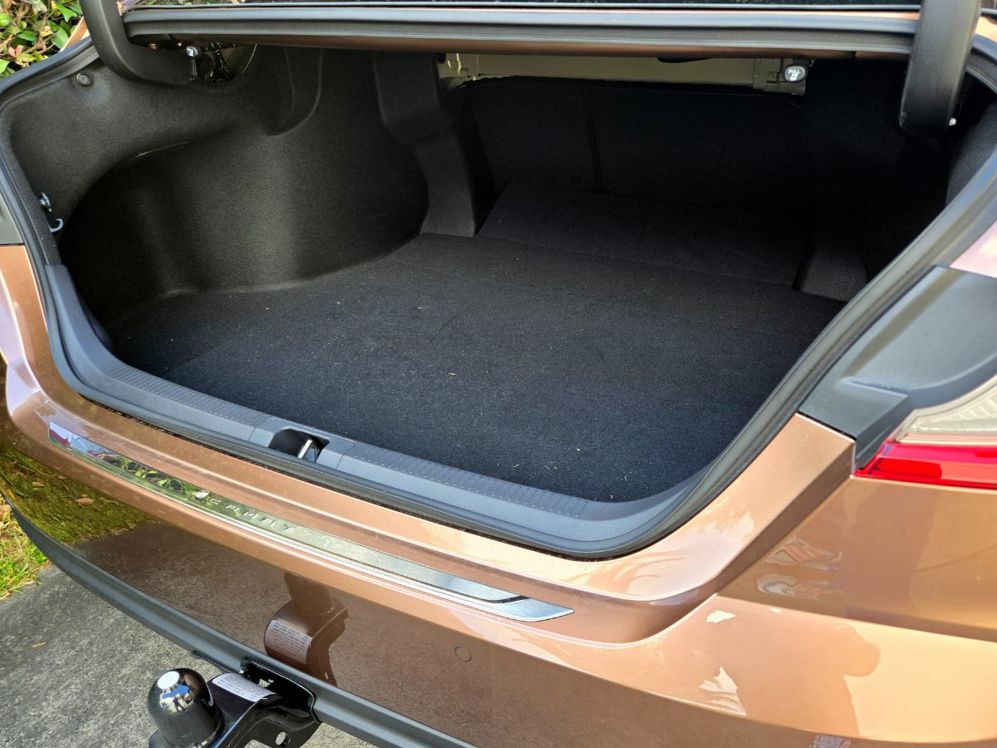Know what’s niche and exciting for a motoring writer in 2024? A large, mainstream sedan. A Toyota Camry. We live in an SUV world and that includes Toyota New Zealand: of the 14 separate passenger-car model lines it sells, 11 are SUV-based (and two are coupes).

TOYOTA CAMRY ZR: Engine 2.5-litre petrol 4-cylinder with hybrid-electric system Power 170kW (combined)/221Nm Gearbox Electronic continuously variable, FWD 0-100km/h 7.2 seconds Consumption 4.5l/100km (3P-WLTP) Price $57,990.
Camry is the sole three-box sedan and yes, it’s still going. Recipient of a big facelift, even. The new model has had a pretty effective top-and-tail, with a blade-like front and Tesla Model 3-style tail-lights.
It’s been hybrid-only for years, but you could almost say the styling has now been electrified; it looks much more like part of the same family as the bZ4X for example, and has even dropped the decades-old and very familiar Toyota “Hybrid” badge in favour of “HEV”, which is a nice match for the bZ’s “BEV” graphic.
Inside, there’s a swish new dashboard with digital-everything and in our top-specification ZR model, two separate 12.3in displays: one for infotainment and another for the main instrument panel. The big styling feature is a ribbed panel that runs from the passenger-side ventilation outlet across to the infotainment; respectfully retro-cool without being overdone.

It’s all nicely laid-out and beautifully finished; in fact, it makes the cabin of a RAV4 look positively dowdy.
You could almost say the styling has been electrified; Camry now looks much more like part of the same family as the bZ4X.
Toyota is a teeny bit vague about the changes to the Camry’s hybrid system, which is based around a 2.5-litre petrol engine. Total output is up by 10kW to 170kW, but fuel consumption is down from 4.7l/100km to 4.5l/100km for our ZR test car. A lithium-ion battery is pitched as a key spec-point, but Camry has had that since an update in 2018.

But you know, it’s faster and more efficient. That’s probably all a Camry buyer really needs to know; maybe even just one of those things.
It’s a car that makes you smile because it has such a specific sense of purpose.
Surprise, surprise: in practical terms, the hybrid system in this thing is brilliant. As it should be. Lest we forget, prior to the RAV4 Hybrid in 2019, Camry was TNZ’s biggest-selling petrol-electric car by far and in fact the most popular electrified vehicle of any kind. The technology has been honed for years.

We completed one urban commute (admittedly in hybrid-friendly, very heavy traffic) from the suburbs to the city at 2.9l/100km, which is a staggering result for such a big car. In mixed real-world driving, sub-5.0l/100km is a doddle.
The drive modes are irrelevant because the car is brilliant at deciding what it needs to do and it’ll save every ounce of fuel it can at every opportunity.
The hybrid system runs on battery little-and-often, little-and-often, depleting and recharging very quickly. The transition between EV and hybrid running is seamless.

At 1625kg it’s not a heavy vehicle by any means, despite its size and hybrid hardware, so it can actually feel downright punchy if you want it to; and yes, it does have a Sport mode, along with Eco and Normal (aren’t they the same thing in this car?). There’s also a dedicated EV button and really, the whole lot are irrelevant because the car is brilliant at deciding what it needs to do and it’ll save every ounce of fuel it can at every opportunity.
It’s also generally rather nice to drive. Soft rather than sporting, but there’s a sense that the steering and chassis have been finessed and balanced to near-perfection for a big, comfy sedan. Which is what the Camry aims to be. It’s a car that makes you smile because it has such a specific sense of purpose.

The top ZR is $57,990 but lavishly equipped, with upsized 18in machined alloy wheels, the big 12.3in instrument panel (GX is 8in) power adjustment for both front seats with heating/ventilation, and a panoramic roof. Price-wise it sits between the RAV4 XSE and Limited.
It’s a big car (4.9m long) and it provides big space inside - but maybe not as big as you think in the back. Headroom is generous, legroom pretty good - but you do find your toes jammed under the low-set front-seat squabs when there are taller people in the front.

The boot is pleasingly capacious and of course, the big difference between a sedan and SUV is that your cargo is out of sight and more secure. However, the lid is manual, the rear seatbacks only fold 60/40 and load-through space is quite narrow thanks to some structural stuff around the C-pillar area. Not perfectly practical, but still pretty good.
Speaking of which, you might notice the towbar on our test ZR. That’s possibly an example of TNZ over-reaching, because while many Toyota hybrids do a decent job of towing, a Camry can only manage 400kg; you can do almost double that in a Suzuki Ignis.
But still, what a machine. There’s definitely a novelty element to Camry now, given that it’s essentially in a class of one: the likes of Ford Mondeo, Mazda6 and even Skoda Superb sedans have all quietly disappeared from the Kiwi market.
But we all loved it and it became a firm friend and office talking-point for the week-and-a-bit we had it. It was Camry this, Camry that, and we didn’t mention taxis once.





